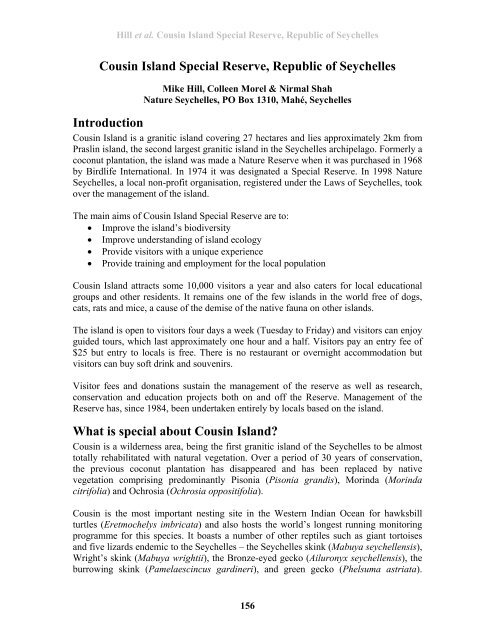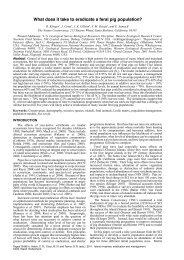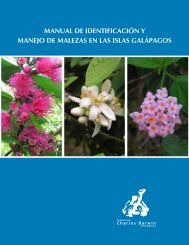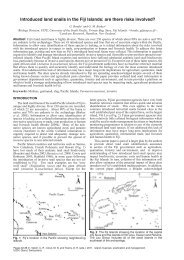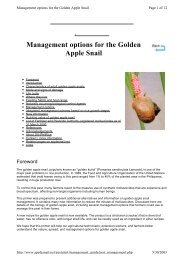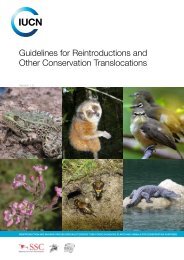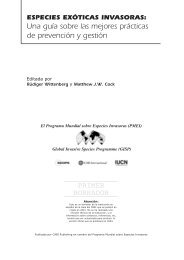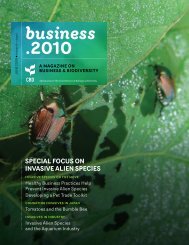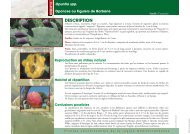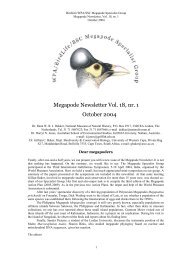Woody Invasive Species: A Regional Assessment - IUCN Invasive ...
Woody Invasive Species: A Regional Assessment - IUCN Invasive ...
Woody Invasive Species: A Regional Assessment - IUCN Invasive ...
You also want an ePaper? Increase the reach of your titles
YUMPU automatically turns print PDFs into web optimized ePapers that Google loves.
Hill et al. Cousin Island Special Reserve, Republic of Seychelles<br />
Cousin Island Special Reserve, Republic of Seychelles<br />
Mike Hill, Colleen Morel & Nirmal Shah<br />
Nature Seychelles, PO Box 1310, Mahé, Seychelles<br />
Introduction<br />
Cousin Island is a granitic island covering 27 hectares and lies approximately 2km from<br />
Praslin island, the second largest granitic island in the Seychelles archipelago. Formerly a<br />
coconut plantation, the island was made a Nature Reserve when it was purchased in 1968<br />
by Birdlife International. In 1974 it was designated a Special Reserve. In 1998 Nature<br />
Seychelles, a local non-profit organisation, registered under the Laws of Seychelles, took<br />
over the management of the island.<br />
The main aims of Cousin Island Special Reserve are to:<br />
• Improve the island’s biodiversity<br />
• Improve understanding of island ecology<br />
• Provide visitors with a unique experience<br />
• Provide training and employment for the local population<br />
Cousin Island attracts some 10,000 visitors a year and also caters for local educational<br />
groups and other residents. It remains one of the few islands in the world free of dogs,<br />
cats, rats and mice, a cause of the demise of the native fauna on other islands.<br />
The island is open to visitors four days a week (Tuesday to Friday) and visitors can enjoy<br />
guided tours, which last approximately one hour and a half. Visitors pay an entry fee of<br />
$25 but entry to locals is free. There is no restaurant or overnight accommodation but<br />
visitors can buy soft drink and souvenirs.<br />
Visitor fees and donations sustain the management of the reserve as well as research,<br />
conservation and education projects both on and off the Reserve. Management of the<br />
Reserve has, since 1984, been undertaken entirely by locals based on the island.<br />
What is special about Cousin Island?<br />
Cousin is a wilderness area, being the first granitic island of the Seychelles to be almost<br />
totally rehabilitated with natural vegetation. Over a period of 30 years of conservation,<br />
the previous coconut plantation has disappeared and has been replaced by native<br />
vegetation comprising predominantly Pisonia (Pisonia grandis), Morinda (Morinda<br />
citrifolia) and Ochrosia (Ochrosia oppositifolia).<br />
Cousin is the most important nesting site in the Western Indian Ocean for hawksbill<br />
turtles (Eretmochelys imbricata) and also hosts the world’s longest running monitoring<br />
programme for this species. It boasts a number of other reptiles such as giant tortoises<br />
and five lizards endemic to the Seychelles – the Seychelles skink (Mabuya seychellensis),<br />
Wright’s skink (Mabuya wrightii), the Bronze-eyed gecko (Ailuronyx seychellensis), the<br />
burrowing skink (Pamelaescincus gardineri), and green gecko (Phelsuma astriata).<br />
156


